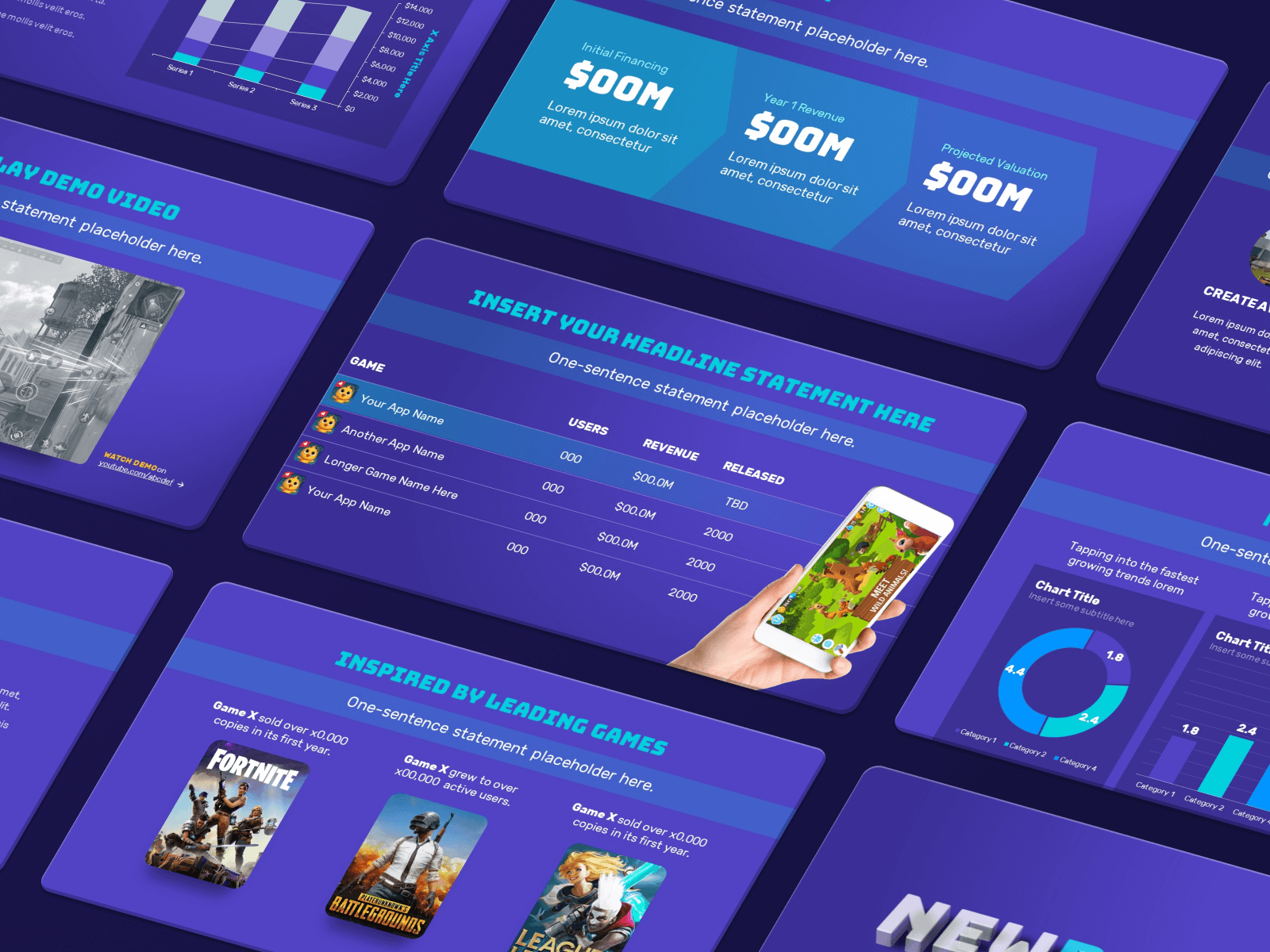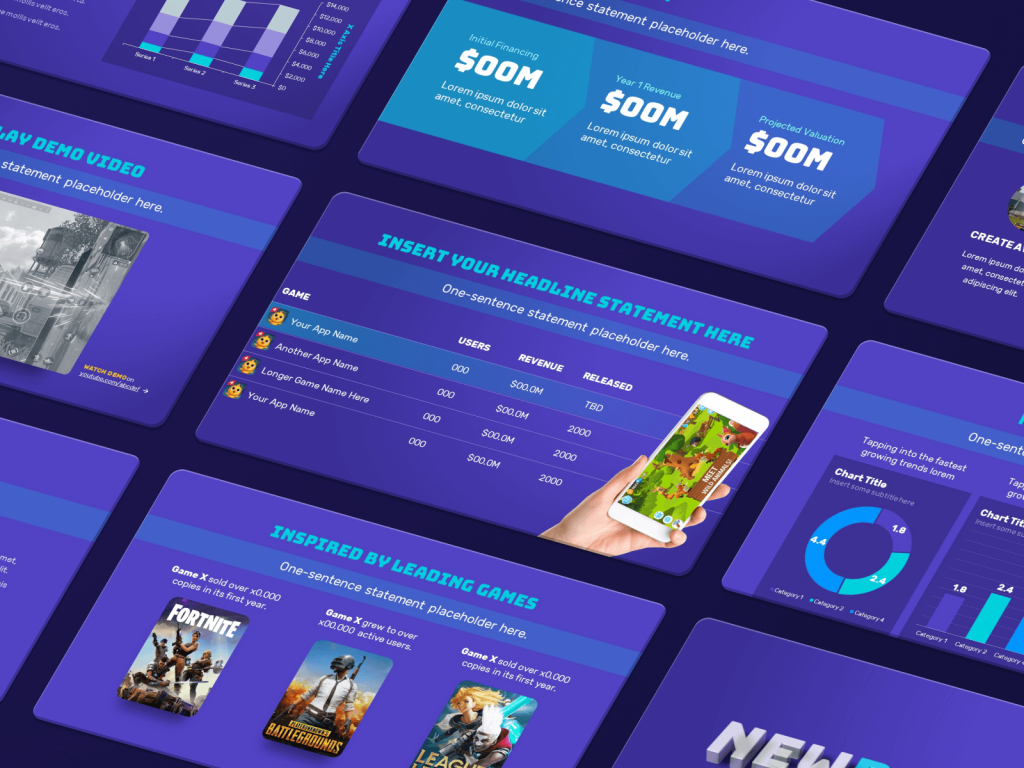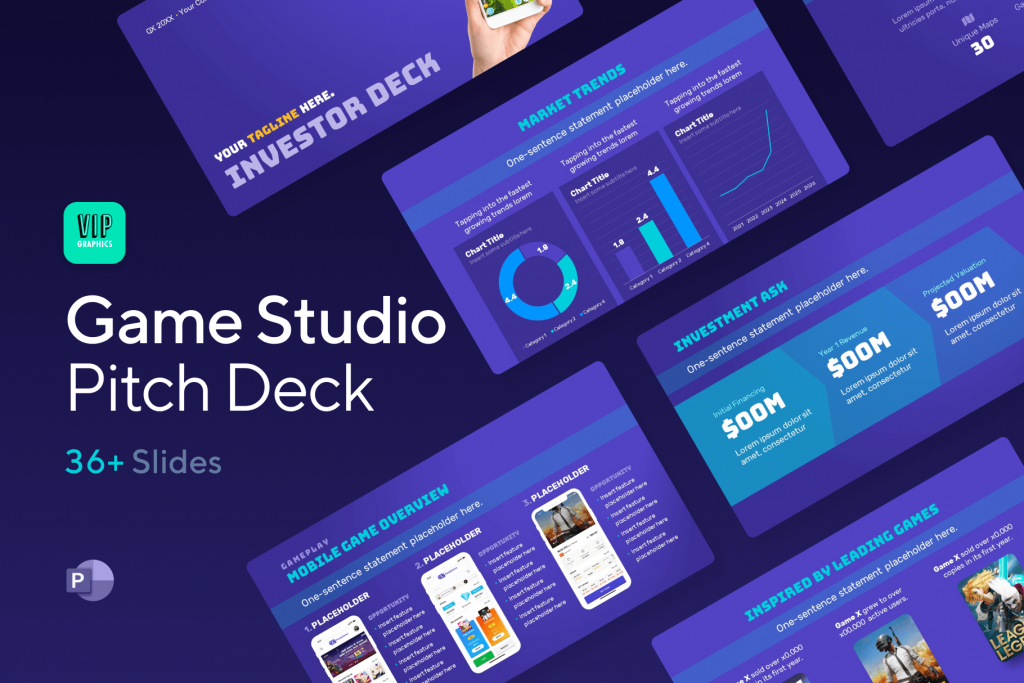Video games are a billion-dollar business and have been for many years. The emergence of social networks and smart devices introduced new categories such as mobile gaming.
Whilst indie developers have steadily gained market share in the last decade (indie games made up 40% of all units sold on Steam in 2021), most still rely upon publishers for funding, distribution and administrative support. Creating an effective video game pitch deck is a critical piece of the puzzle for video game studios seeking publishers & investors.
In this article, we will discuss how to create a video game pitch deck to sign publishers and investors:
What is a game studio pitch deck?
Whether you’re creating a PC game, console game, mobile game, or gamified app, you’re going to need a video game pitch deck. Your pitch deck will serve as a valuable tool to sell your game to publishers, investors, or anyone else within the industry. Moreover, creating a pitch deck is an insightful exercise to explain why and how you are making this game. The pitch deck allows you to delve into the specifics of overall gameplay, audience, go-to-market plan, and more.
What is the purpose of a video game pitch deck?
Your game pitch deck will be the most essential tool in landing investors and signing with publishers. Publishers provide indie game developers with not only funding, but also widespread distribution and resource necessary to ensure the greatest possible odds of success.
There are quite a few reasons that signing with a publisher is an appealing prospect for most game studios:
- First and foremost, publishers offer the funding necessary to support the development of your game
- Game publishers also have the opportunity to release and distribute your product as widely as possible, across all platforms and marketplaces
- Publishers often perform other tasks that go into releasing a game such as testing, localization, porting to other platforms, managing relationships with distribution platforms like Steam, working on branding strategy, administering store pages, and more.
In the words of Paul Kilduff-Taylor, co-founder of Mode 7 Games (the developer behind the Frozen Synapse series):
“To have a chance at a good level of success, you basically have to nail everything. That’s a really tall order, so devs are simply looking to stack the odds in their favour.”
How to create the perfect video game pitch deck to impress publishers:
As an indie developer, your game needs the right publisher to help it take over the market. But how do you create an effective pitch deck to help you land the right publisher?
Most pitch decks are ten to fifteen slides and breakdown key information that investors and publishers will be interested in. Although investor presentations vary based upon the industry, video game pitch decks typically follow the formula below:
1. Title / Introduction Slide
Your pitch’s title page is a poster or compelling visual that conveys the tone and ambiance of your game or studio. Usually, most game studio decks include some of the game art (ie. characters, backgrounds) on the cover slide (ie. PLAYSTUDIOS). Contact information can also be shared on the title page if needed. Your pitch deck’s introduction should by memorable, exciting, and captivating — it’s your first impression!
2. Inspiration / Our Story Slide
Effective pitch decks (regardless of industry) should tell a story. Video game pitch decks generally begin with your story: how did you come up with the idea for the game, what got you excited about the opportunity, and what made you take the leap? This slide is often a good place to cite inspiration from existing games that have done well — listing successful titles will help investors see comparable examples of successful games like yours.
3. Gameplay Slide
This is the fun part: where you get to tell your audience about the game itself. Depending on the stage of development, you may or may not have mockups and demos to present, but visuals are always recommended. The content of this slide should allow your reader to grasp the game in seconds, and also convince them why players will want to keep playing.
4. Audience Slide
Who is your game’s target audience? This is perhaps the most important question for publishers and investors, given these will be your customers. This component of your pitch deck should include market research with trends & statistics supporting your hypothesis such as content/genre preferences, purchasing behavior, demographics, and market size.
A detailed summary of your target audience and why they will enjoy your game is the first step in convincing investors to back your game. Be sure to include demographics & interests (both quantitative and qualitative data), as well as trends that favor your success. You can also include specific features or elements of the game that may support your chances of successful reception.
5. Learnings & Data Slide
While market data speaks to the opportunity, investors will want to see how you have validated the demand for this game. This a good place to mention experiments, prototypes, surveys and waitlists to demonstrate you have tested the market and have data to support your hypotheses. This slide should make a compelling argument for why this game should exist now.
6. Traction Slide
Besides the learnings, your pitch deck should emphasize what have you accomplished so far with the game (ie. number of players, soft launch). The specifics will vary depending on the stage of development, but your pitch deck should showcase early KPIs (ie. community size, social following and waitlist signups) somewhere? You can also speak to the benchmarks you are planning to hit.
7. Team Slide
Present a complete list of the project’s chief team members including their bios, experience, and roles. If you are an indie developer, you can highlight your experience and network here. It’s not a dealbreaker if you don’t have all the necessary skills in house or to lack certain experience, but you should have a plan to cover all the bases (which can be a list of early hire).
8. Marketing Slide
Many indie developers plan to leave marketing entirely to publishers (which is often fine), but investors will generally expect developers to at least have a plan for community growth. Most successful (and sustainable) games weave community closely into their game. That said, you can add the names and details of the potential marketing channels for the project — this is the perfect place to highlight the names of any notable brands or partners you may be in discussions with.
9. Production Roadmap Slide
The roadmap slide should lay out your production milestones (generally for at least 18 months). This can be a simple timeline of the milestones you plan on hitting, and how will your metrics improve in turn. Investors will generally be looking for a firm timeline to completion — an infinite release period is a surefire recipe for to too much bloat (plus, it delays return on investment). This section should go hand-in-hand with your budget and will serve as a helpful exercise to frame your developer’s expectation. Consider risks & roadblocks you may face, and how you will navigate them.
10. Budget / Ask Slide
Finally, the investment slide should describe the overall budget of the project. You can break down the financial details required for each phase of production. Apart from funding capital, the ask slide should also consider the strategic support that your investor may be able to provide (customize this to each publisher you speak to).
How to create a game studio pitch deck:
The video game pitch deck is a crucial tool for game studios and indie game developers who want to secure capital and commitments from investors & publishers. You might be interested in the popular Video Game Studio Pitch Deck Template designed by our team at VIP.graphics: cutting-edge slides design by experts who have helped secure millions in funding for video game studios. Creating a professional video game pitch deck is quick and easy with this template — check it out here.


